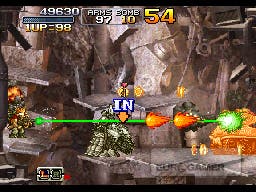Metal Slug 7
In with the Neo.
For over thirteen years now, SNK has been releasing much the same videogame over and over again. In mechanical, visual and thematic terms, Metal Slug's developments are measured in minutiae: tweaks to format indiscernible by all but the aficionado. What other series continues to use the same sprites, sound effects and ideas found in its debut more than a decade ago?
Perhaps the secret of Metal Slug's success lies in its predictability then. There's an assurance that these firecracker shooters will always offer the same precise run-and-gunplay, presented on a backdrop of a slapstick war waged by coward Nazis, dripping zombies and mecha-camels. Indeed, Metal Slug's expressive hand-drawn sprites, birthed on that Bentley of 16-bit consoles, the Neo-Geo AES, are kept alive through choice, not necessity. Metal Slug's disastrous foray into 3D in 2006 ensured that for this, the seventh sequel to the series, SNK Playmore has retreated to a Tom and Jerry cartoon approach to the crimson horrors of war. It's a wise decision to stick to tradition, and one taken despite the fact that, for the first time ever, the console version has no arcade release to which to adhere.
Metal Slug 7's fundamentals remain immovable despite the platform change. As ever, you control a single soldier (one of six men and women), and must work your way through 2D environments shooting enemies before they shoot you. You've no health bar: it's one shot one kill and your default pistol (or machine gun if you're playing on 'Beginner' difficulty) is holstered next to a clutch of grenades. Scattered throughout each level are a number of ageing POWs, naked save for a linen cloth that cups their modesty, who supply you with new weapons. Finally, should you find any vacant vehicles along the way, you can ride them into the glorious cannon fire.

But beneath these top-line consistencies are a number of design changes that in some ways alter the way the game is played. These tweaks aren't quite as visual as those in previous games, where eating too much food would explode your character into a grotesque fatty or where puke from a zombie would turn you into one of the undead (while allowing you to play in this new guise). Rather the developer's focused on mechanical changes such as the ability to hold two weapons at once and cycle between them, and introducing new weapons such as the super blade and Tesla gun which affect on-the-ground tactics.
While the series has always been in part about high scores, here that focus is sharpened by way of the coins that spew from fallen enemies and masonry, their value increasing exponentially as you collect them, Mario-style. A score multiplier system, which is kept up by chaining enemies at a steady rate, adds another layer of complexity. When the gauge is maxed out, all destroyed enemies and objects release coins for a short period, ramping up the spread of possible scores for each level. Considering this new focus, it's a shame that the game's leaderboards are cart-specific. While you do get to compete across leaderboards for each of the game's three difficulties, the option to connect to an online scoreboard would have been a meaningful addition.
In technical terms, the game performs well on the DS, although it's clear that some graphical concessions have been made to the hardware. Some background textures aren't hand-drawn and the scaling effects as the levels scroll are incongruous to the pixel-perfect heritage of the series. There is some slowdown when the screen fills with blood and bullets but this has always been the case with Metal Slug, and what's normally a technological shortcoming acts as a useful mechanism for helping you through the most tortuous bullet mazes. Less easy to forgive is the lacklustre level design, which provides only glimpses of the flair and creativity that defines the earlier games in the series. Caves and mountainsides form the stock locations, their drab, samey colour schemes leaving you longing for the vibrant diversity of Metal Slug 2 and 3's rich vistas.

Almost no use is made of the DS' hardware capabilities. The top screen houses all of the action while the touch-screen displays a heavily pixellated version of the level, which can be scrolled around to show the locations of weapons and POWs. Outside of the main game, the Combat School - first encountered in the PlayStation and Saturn ports of the first Metal Slug - makes a welcome return. Here you can flirt with a brusque, blonde Drill Instructor who challenges you to complete levels against the clock, collect specific items in a level or simply to destroy objects within a time limit. This section adds significant value, particularly as, for the first time in the series, there is no multiplayer mode to improve longevity.
However, where it matters most, Metal Slug 7 delivers. The shrink from arcade to DS screen in no way cramps the experience, offering the same amount of exacting control as it ever did. The new weapons and vehicles add little to the formula, but the strength of the foundations upon which the game builds is self-evident. If SNK Playmore can match its mechanical creativity with the kind of level design ingenuity displayed by the SNK of old, then Metal Slug 8 could well be the series' high point. One thing's for sure: as with Metal Slug 7, it will no doubt be a game we've, one way or another, already played many times before. And we won't even mind.

